

Suunto Blog
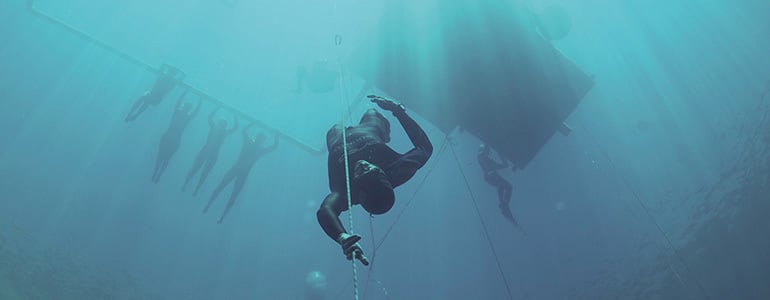
What freedivers can learn from the top of the world
Suunto ambassador and freediver William Trubridge has given his life to the sport of diving as deep into the ocean’s depths as any human can without scuba equipment. But he recently decided to explore the other end of the planet – the heights of the Himayalas. He trekked 300 km, with 10,000 m of vertical ascent. The longest day was 13 hours of hiking. We asked him what he learned at the top of the world.
Why did you go trekking in Nepal? It was mainly to do something together with my father David and brother Sam, as we live in separate parts of the world. We chose the Himalayas, as my father loves the mountains, and neither Sam nor myself have seen those kinds of mountains.
"I think freediving training definitely has a crossover effect to mountain climbing."
Where were you?We trekked to Kanchenjunga base camp in eastern Nepal. Kanchenjunga is the third highest mountain in the world, and one of the holiest. The remoteness of this area means there are few trekkers and even fewer amenities. This is exactly what we wanted.
At 5163 m, the atmosphere is half as dense as at sea level, meaning half the volume of oxygen per breath.Vastly different environment than you’re used to – how was it? It was humbling. I realised just how un-adapted my body is to that kind of world. After 12 years of only freediving training in the water my knees were unacquainted with any kind of impact, and the first day's gruelling descent paid its toll. In fact, all the descents were tough for me. I really enjoyed going uphill because I was able to push myself. You’re used to having a lack of oxygen – how was the higher altitude for you? The altitude wasn't a factor. Our ascent was very gradual, which allowed the body time to adapt. I think freediving training definitely has a crossover effect to mountain climbing by developing haemoglobin oxygen storage in the blood. Freediving training stimulates erythropoiesis, which is the generation of new red blood cells, in order to store and transfer more oxygen. This benefits all hypoxic activities, whether apnea or trekking at altitude. What did you learn? It gave me an appreciation of volumes, and the vastness of the mountains, but also the seas. When looking up at a towering 7,000 m peak and thinking that huge mass could disappear in the huge well that is our planet's oceans it made me marvel at the scale of these environments. What can freedivers learn from trekking or the mountains? Trekking can be a kind of meditation, as the slow pace of changing scenery lulls your mind. It also gives you an appreciation for the 'other end of the spectrum' of our planet's ecosystem, and for the many other various forms that water can take: snow, rain, mist, waterfalls and rivers.
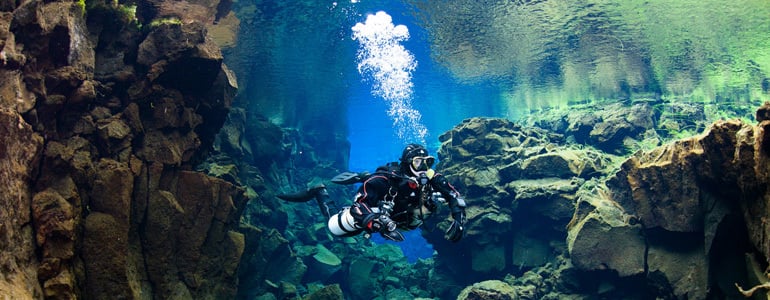
Diving the Shipwrecks of Bell Island
Suunto ambassador and underwater explorer Jill Heinerth dives the world's most incredible locations. Bell Island, Newfoundland is one such site. The video below shows why it's a diver's paradise.
Tell us about the Bell Island and its wrecks.
Bell Island is one of the few locations in North America that was under attack by German forces during the Second World War. In 1942, U-boats raided the island twice, sinking four iron ore carriers and destroying a loading wharf, killing more than 60 men. During the war, the mines on Bell Island, Newfoundland supplied iron ore that accounted for one-third of Canada's steel production. Germany knew that they could interrupt the flow of ore, even temporarily, and Canada's war output could be seriously affected.
Click here to find out more about Jill Heinerth
What drew you to dive there?
I was part of a team documenting the recovery of a sextant from the wreck of the Rose Castle. Rick Stanley, owner of Ocean Quest Adventure Resort, worked for over a year to secure the correct permits and line up provincial conservators to preserve the important artifact that will be eventually be displayed in an extensive museum on Bell Island.
Why is it such an amazing dive location?
Newfoundland is a great destination for the adventurous divers. Today, divers visiting Newfoundland’s rich waters, can dive these remarkable wrecks that have transformed into stunning and colorful reef structures.
Is there more to explore there?
In the summer, divers can also enjoy diving on icebergs and swimming with whales that gather in the area to feed on capelin. I’ve been recently working with other cave divers to document the submerged mines which cover over 100 square kms. This coming season, mine operators hope to open diving activities to qualified cave divers visiting the area. The mine is still filled with all the equipment and artifacts of operations there. Seeing the large equipment, miner’s graffiti and personal items is an interesting opportunity.
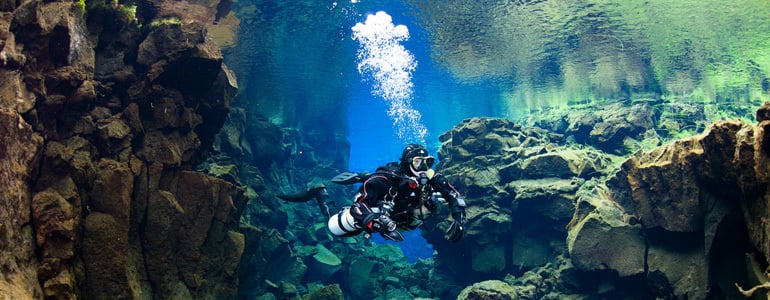
Dancing with Devil Rays
Suunto ambassador Jill Heinerth recently explored dive locations around the Azores islands in the Atlantic Ocean. The destination’s wrecks, megalithic steps and lava caverns blew her mind, but swimming with devil rays was one of the greatest diving experiences of her life.
The devil ray or mobula is species of eagle ray that can grow up to five meters long. They are sometimes called flying rays because of their propensity to breach the ocean surface. They are endangered because of water pollution and bycatch capture.
Underwater explorer and photographer Jill Heinerth swam with about 30 devil rays in open ocean over a sea mount off Santa Maria Island in the Azores. Devil rays visit the area to feed. Jill recounts the experience below.
“As I patiently waited, they seemed to line up in formation and repeatedly moved closer and closer with graceful ease,” she says. “Each followed along the same path arching towards me, sliding sideways for a look and then turning to come even closer. “Hovering over top of me, they would pause while I held my breath as long as I could. Finally I would exhale bubbles from the scuba regulator and the ray would slip away and allow the next one to move over top of me. “It seemed as though they were interested in getting tickled by my stream of bubbles. The dance went on for almost 90 minutes. “It was one of the most spectacular diving experiences of my life."
Press play to watch this beautiful video of that day
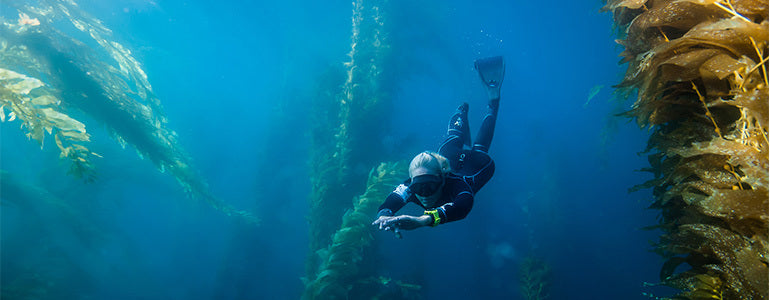
Learning the joy of freediving
You don’t need to be able to hold your breath for minutes to enjoy freediving. Below the Scuba Diver Girls’s Margo Sanchez explains why diving without gear can lead to the best underwater experiences.
Scuba Diver Girls Stephanie Adamson & Margo Sanchez are based in California. © Scuba Diver Girls
Why freedive? There is something very freeing about diving without heavy gear. It is a magical experience when you drop down into the silence of the ocean, but hear the distant chirp of a dolphin or crackling of shrimp. The sport gives myriad benefits over time. Learning the breathing and relaxation techniques teaches you how to relax your mind and body in many situations, both in and out of the water. After practicing, you get more proficient at using those techniques and can challenge yourself to extend the amount of time you can stay under the water.
Press play and watch a harbour seal play with the Scuba Diver Girls How did you get into it? I started out scuba diving and gained my passion for the underwater world with a tank on my back. But it wasn’t until I started diving with sharks that I realized I was not able to get close while I was blowing bubbles loudly on open circuit. I decided to try taking off my tank and diving down with them while holding my breath instead. Once I realized that this brought a whole new dimension to my diving, I decided to take the beginner freediving training with SSI (Scuba Schools International).
“As you swim through the forest, the sun streams through the kelp canopy like stained glass.”
Best freediving experiences? We have been all over the world both scuba and freediving. There are beautiful coral reefs in remote locations of the world that are breathtaking as you skim along the top checking out the little critters that flit in and out. Waking up at dawn in tropical locations to silently slip into the water and then skimming across the surface, looking for what the location has to offer, before finally gliding through its depths is one of the most exciting experiences a diver can have. Click play to see the beauty of our underewater world and the freedom found in exploring itStop, you’re making us jealous! But go on anyway… Probably my favorite place to freedive is right in our back yard in La Jolla California. Dropping down beneath the surface into a thriving kelp forest is an ethereal experience. As you swim through the forest, the sun streams through the kelp canopy like stained glass and a multitude of fish congregate while you swim by. Sometimes you get a visit from a frisky sea lion or a harbor seal tugging on your long fins while other times you swim gracefully alongside a sleek grey shark while it looks into your eye and you hold a common respect for each other through that connection. Most of these sea life encounters can only be experienced on a breath hold and a dive.
“Most of these sea life encounters can only be experienced on a breath hold and a dive.”
© Lesley Grey Alstrand
How do I learn?
Starting out by snorkeling is a great first step. Finding an instructor is next. There will be some out of the water training first for the diver to better understand how freediving impacts the body. For example, what the ‘mammalian diving reflex’ does once in the water, what a diaphragm spasm is and how you should react to it and what the importance of clearing the ears and how often is etc. These principles are important as a foundation so that when you get into the water, you understand what is happening with your body as you dive. Golden safety rules? The most important is always dive with a partner. Understanding your body’s limitations and physical reactions to breath hold is also important. Which is why this is a progressive sport. It is important to learn about your body before progressing to the next depth or time threshold.
© Ashley HauckGreatest challenges? There are two big challenges that may come as a surprise when a new diver begins. First, freediving is very mentally challenging. It’s natural to feel anxiety when holding your breath under water. Learning how to calm your mind is important. The second big challenge that many people face is ear trouble. Your ears are very sensitive and when you dive under the water it’s important to learn and understand not only the technique to clear them effectively, but how often.
“Since I started freediving, I am more relaxed, happy and in shape than I have ever been.”
Anything else? The first goal is to have fun! A freediver should first enjoy the experience. This means taking the training at your own pace and not setting unrealistic goals for yourself in holding your breath or going to greater depths.
© Ashley HauckWhat else do you get from freediving? Not only do the techniques and breath hold skills assist me in enjoying some of the most amazing sea life, but they also help me in my everyday life with stress management. Since I started freediving, I am more relaxed, happy and in shape than I have ever been. The sport brings peace to your life through the silence of the underwater world.
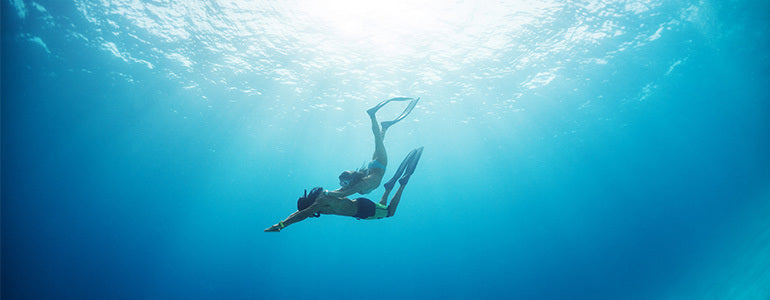
Finding harmony in the deep blue sea
Japanese freediver and former model Tomoka Fukuda has one dream: to explore the world’s oceans as a wandering freediver. One word describes what Tomoka Fukuda loves about freediving. “Harmony,” she says, “between my body, my mind and the ocean. “When I dive in the ocean, I am diving into myself. I can see inside myself clearly. When I have a good dive, I feel that I am a small part of this world where everything is connected.” Tomoka wasn’t always so Zen. Prior to first freediving eight years ago, she worked as a model and ran her own beauty salon. She’s the first to admit it: as a model, she was a little bit crazy – lots of parties, busyness and stress. But then she found freediving. “The ocean has taught me many things,” the 37-year-old says on the phone from Greece, where she is currently training. “You can’t lie to the ocean. It’s like a mirror. I learned that our limitations are only in our mind and you can extend them.”
Click play to watch this video of Tomoka diving with Fernando Stalla
Originally from Japan’s northernmost island Hokkaido, Tomoka’s enduring connection to the ocean began on family holidays to a cousin’s home by the sea. She went from a child splashing around at the beach, to becoming a competitive backstroke swimmer. But her life really changed when she visited Okinawa, Japan’s southernmost island, and tried scuba diving and freediving for the first time. “The ocean was so beautiful that it stunned me,” she says. “I decided to relocate my whole life there so I could be close to it.” There, Tomoka met an experienced spear fisherman who became her mentor. They went freediving every week and he taught her everything he knew about freediving and the underwater world. Before long freediving became more than just a leisure sport. The AIDA Depth World Championship was held in Okinawa in 2010 and Tomoka helped as a safety diver for the competitors. “I saw so many amazing freedivers and I knew I wanted to do that too so I decided then to train seriously.” Just one year later, Tomoka competed in the AIDA Depth World Championship in Kalamata. The following year, during the 2012 Suunto Vertical Blue freediving competition in Dean’s Blue Hole, Tomoka dived to 80 m, realizing a long held goal. That same year, she also won Suunto’s People’s Choice Award for Best Female Newcomer at the AIDA Depth World Championship. And she won second place in the women’s division at the 2015 Suunto Vertical Blue competition. The wandering freediver is also well on the way to fulfilling her dream of freediving all around the world. This year alone she’s plunged into the waters of seven countries. Her favourite locations to date are Greece, the Maldives, the Bahamas, Italy’s Puglia and Egypt’s Dahab. “Before, I wanted everything, now I don’t need anything,” Tomoka says. “I am fulfilled solely by ocean happiness and do not have material desires.
“I just want to dive in the ocean. The ocean is my world.”
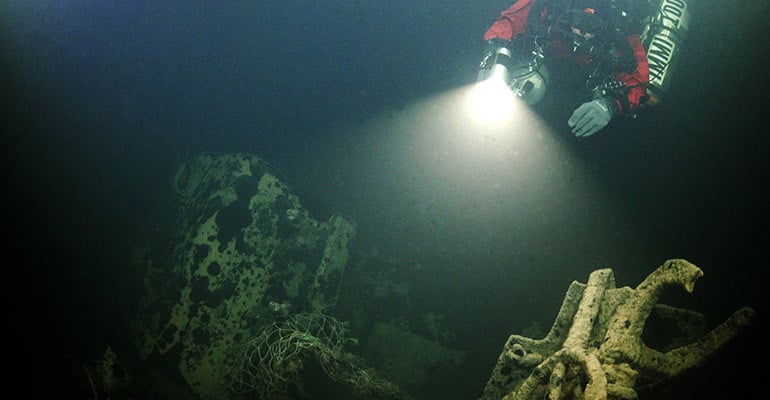
FINDING THE LAST MISSING GERMAN WW2 U-BOAT IN THE GULF OF FINLAND
“For those who love adventure and exploration, the fraction of a second when you realise that you have actually rewritten the history or confirmed something that has only been speculated on before, is an unforgettable moment,” says underwater explorer Immi Wallin.
Immi Wallin and her Subzone team discovered a missing German U-boat off the Estonian coast in August. Here, Wallin tells the story for the first time.
“The secrets of the seas, with its hidden lost ships, do not reveal themselves easily. To find these secrets, you sometimes need perfect weather, plotting information from the archives of sea charts and then checking a mysterious marking on your chart, which you do not remember how and why you put down in the first place.
On August 12th, about a month ago, I went to check a marking on my sea chart with side scan sonar together along with my colleague. The marking had bothered me for some time because I did not remember what it was and it seemed to be next to a mine row and in a patrol area of a still missing German U-boat.
U679’s closed hatch and periscope
U-679 gave a weather report on December 27th 1944 while in the Gulf of Finland. She had rendezvoused at sea with U-637 and U-745 in the evening of December 26th. U-745 had delivered encrypted communication.
On January 9th, Soviet MO-124 detected a submarine four miles northeast of the Pakri lighthouse and dropped eight large and 20 small depth charges. The Germans assumed that MO-124 had sunk U-679, but the Soviets did not believe it because they didn't find any evidence of a destroyed submarine in the area. Nevertheless, the cause for disappearance of U-679 that was recorded in Western literature was depth charge attack by MO-124. The fact that U-679 did not reply to a message sent on January 10th, 1945 supported this theory.
Depth, poor visibility, hydrogen sulphide, hypoxia and trawl nets made the dive a challenge
Back to August 12th 2015. I decided to survey the whole mine row laid in January 1945 that was plotted next to the marking I had on my sea chart. When reaching the marked spot on the chart, something happened on the screen of the side scan sonar. The moment I saw a submarine image appearing on the sonar screen was exactly the fraction of a second that I will remember forever. The image showed a Type 7C German submarine – already recognizable from the image. There was only one that had not been found yet – U-679. That same night the Estonian National Heritage Board was informed about the discovery.
The first dive to U-679 was conducted on September 10th. Due to the depth, 90 m, we needed a flat sea and a team of deep divers, support divers and boat handlers. The aim for the dive was to document the wreck’s condition. The video material was provided to the authorities.
Conditions were good at the surface, but more challenging in the water. There were slight horizontal currents all the way from the surface to the bottom. The most challenging part was the visibility that worsened towards the depths.
We passed several white cloud layers and just about 10 m above the bottom the visibility got very bad and I could smell the hydrogen sulphide typical for a sea bottom with hypoxia. The shape of the submarine’s conning tower became slightly visible in the light we carried with us. The shot line was in the middle of the conning tower, so we decided to shoot video around the conning tower having possibility to find back to the shot line.
U679’s 37mm antiaircraft gun
The video camera, once again, could see much more than our eyes. We could confirm what was visible already on the side scan sonar image. The conning tower was type IV, having 3.7 cm anti-aircraft gun on the lower wintergarten and two 2 cm zwilling anti-aircraft guns on the upper wintergarten. The hatches were closed.
U-679 was lost with all hands, so the wreck is also a war grave for 51 men who lost their lives serving their country. The wreck will be respected as these men’s final resting place and as a historical monument of the war event. U-679 is now under state protection set by Estonian Heritage Board.”






































































